Introduction to Hookah Diving
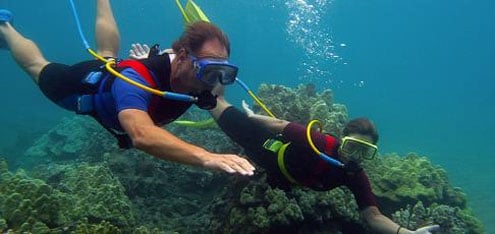
Hookah diving, also known as surface supply diving, is ideal for someone who wants to explore underwater without the cumbersome gear of traditional scuba diving. With a hookah diving system, you get to explore with minimal interference in your range of motion.
A hookah diving system, also known as Surface Supplied Breathing Apparatus (SSBA), is a great way to move towards traditional scuba diving after you've mastered snorkelling. It mixes the ease and freedom of snorkelling with the underwater breathing capabilities of scuba.
What is Hookah Diving?
Hookah diving consists of a petrol or battery-powered air compressor that delivers air, through a long hose called a down-line, to the diver under the water. It can run for 3 to 3.5 hours on a tank of petrol and supply air to more than one diver at a time (depending upon the size).
Hookah diving systems typically consist of a battery or petrol-powered air compressor that delivers air, through a long hose called a down-line, to the diver under the water. Hookah diving does not require the use of a BCD (though many prefer to) or a first stage regulator. Divers wear a harness or BCD, which is the attachment point for the down-line and optional weight belts. Divers use a second stage regulator that's specifically designed for use with a hookah system. A traditional scuba regulator will typically not work. Some Hookah divers also use an underwater scooter while diving.
Hookah Diving Depth Limits: Hookah diving is usually done in less than 12 metres (40 feet) of water. However, there are hookah systems used by advanced recreational and commercial divers that support one diver to 40 metres (130 ft) or two divers to 25 metres (80 ft) comfortably. Please keep in mind your training, dive experience and capabilities when setting your personal depth limits. Also consider that the Code of Practice for the Tasmanian Abalone Industry for professional hookah divers says, "No dive on Surface Supplied Breathing Apparatus (SSBA) is to be carried out at depths below 30 metres (100 ft)." See also the Industry Standard for Abalone Diving Victoria (V1.2 2014).
We strongly recommend that all hookah divers take an Open Water Scuba Diving course and become a certified diver. All of the safety precautions that apply to scuba diving also apply to hookah diving. You need to learn and understand things like decompression stops, how to use compressed air and dive computers, and other safety factors. Decompression sickness (DCS), commonly called 'the bends', happens when a diver comes to the surface too quickly. It's a serious health and safety issue and can happen with hookah diving. You should also read books on the subject of underwater diving safety and study them thoroughly. This will further familiarise you with the rules of the deep.
Benefits of Hookah Dive Systems
- No heavy scuba cylinders to carry
- No straying away since you're tethered to the hookah system
- Multiple divers can use one hookah system
- Stay underwater longer and dive deeper than snorkelling
- Less expensive than traditional scuba
- Floating platform on the surface alerts other boaters to your whereabouts underwater
Hookah Dive System Types
There are two types of hookah dive systems: Dynamic and Passive.
Dynamic System: A dynamic system is one where the air is provided through the use of a mechanical device, such as a compressor driven by a motor, which could be petrol or electric. The air compressor delivers air at the correct pressure. It has a holding or air reserve tank that provides constant pressure. As the air leaves the tank, more air is added to maintain the pressure. The compressor can be fixed or floating, and petrol or electric.
Passive System: A passive system is one that has no moving parts, but utilises a compressed air reservoir, such as a scuba cylinder to move air. All scuba systems are typically, passive. Some hookah systems for commercial diving utilise a bank of scuba cylinders on the surface as the air supply.
A fixed hookah compressor is placed on a dock or on a boat while in use. Floating means that the air source is on a floating platform that the diver pulls along with them.
Petrol vs Electric Hookah Dive Systems
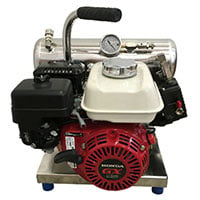
Petrol powered hookah systemHookah systems are available in both petrol and electric-powered versions.
Petrol powered hookah systems typically incorporate a higher output compressor, allowing one or two divers to dive and breathe easily. Most commercial hookah diving systems are petrol systems. Petrol systems do require more maintenance than electric versions. They're also a bit louder. The better Petrol units typically support one diver to 40 metres (130 ft) or two divers to 25 metres (80 ft) comfortably. They are suited for cray (lobster), scallop and abalone hunting, advanced recreational diving, plus commercial diving applications.
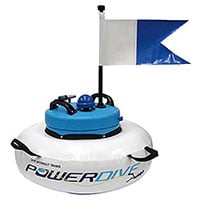
Electric powered hookah systemThe more 'green' electric powered hookah systems require less maintenance than petrol systems. They can be recharged on the boat, or connected to the boat's power supply. They are quiet, easy to start and less prone to corrosion. They typically support one diver to 12 metres (40 ft) or two divers to 6 metres (20 ft) comfortably. Electric units are more suited to families and fun, plus boat owners wanting to do some underwater maintenance at shallow depths.
Uses for a Hookah Dive System
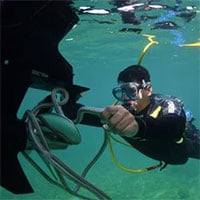
Hookah diver untangles boat propellerHookah diving systems are the perfect tool for:
- Enjoy deeper dives without the cumbersome scuba gear
- Get up close to sea life and coral formations for underwater photography and videography
- Stay underwater till you catch your crayfish (lobster), scallop or abalone bag limit
- Go remote for marine science studies and research
- Get underwater for boat maintenance and emergencies
- Carry out hull inspections
- Perform marina and mooring maintenance
- In the water pool repairs and maintenance
- Golf ball retrieval
- Disabled diving
Components of a Hookah Diving System
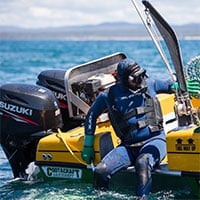
Boat mounted hookah diving systemHookah diving doesn't require quite as much equipment as traditional scuba diving. However, it is vitally important that your Surface Supplied Breathing Apparatus (SSBA) is fit for purpose, properly configured, used and maintained.
Choosing a safe and reliable dive hookah is an incredibly important decision that ultimately, your life WILL depend on.
Hookah Air Compressor
The hookah compressor is THE most important component of the system. Why? The compressor supplies the air on which you will be dependent.
Surface-supplied diving compressors are low-pressure and high-volume, with some operating in a range of 15 to 30 psi, and others 90 to 130 psi. This is vastly different to the high-pressure and low-volume compressors used to fill scuba cylinders that typically operate in a range of 3,000 to 5,000 psi.
The basic principles of a hookah breathing air compressor system is to take clean atmospheric air and compress the air via a reciprocating compressor (single or two stage method). Then cooling and storing the air under pressure via a pressure vessel, which is maintained by the over pressure maintaining valve, the air is then delivered to the filtration part of the compressor where it is filtered and pressure is monitored for delivery and use.
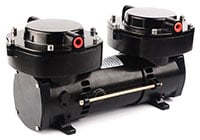
Diaphragm hookah compressorMost hookah diaphragm compressors used for recreational diving are electric-driven, small, lightweight, and of simple design. They typically deliver air at a maximum pressure of 1.85 bar (25 psi). They are commonly constructed of an aluminium alloy, and utilise a rubber 'diaphragm' as the means of air displacement. The moving parts inside a diaphragm hookah compressor are lubricated with Teflon for the life of the unit, and need no additional lubrication; to do so may actually damage the compressor. The air that is delivered by this type of hookah compressor is pure, oil free air. Diaphragm compressors are usually electrically powered.
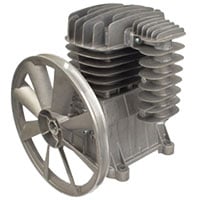
Piston hookah compressorThere are also compressors that use a 'piston' arrangement to displace air. These generally deliver air at a maximum pressures of 9 bar (130 psi). Power for piston compressors is usually a 4-stroke petrol engine (4.0 to 5.0 HP). Most piston compressors utilise an oil bath system lubricated with a high-grade mineral or synthetic compressor oil free of toxic additives. It's essential that a suitable filtration system with the right filtration media be used to remove any solid particles and contamination that may occur.
Hookah compressors operate at a relatively low pressure. The maximum pressure available from the higher capacity piston compressor models is typically about 130 pounds per square inch (psi). Consistently high operating pressures (unless the unit specifically designed for high pressure use) will shorten the life of the compressor by a noticeable degree.
Compressor that can be operated at high pressures permit divers to be submerged at greater depths. Divers working at depths of 12 metres (40 ft) or less will need only 20 to 35 psi for optimum operation of the hookah regulator. Those going deeper with one diver to 40 metres (130 ft) or two divers to 25 metres (80 ft) will need 100 to 130 psi.
Removal of particulate contamination is usually by a paper type dust filter at the air intake. With petrol powered compressors it's essential the engine exhaust is always placed DOWNWIND from the compressor's air inlet.
Most hookah compressors have a built in 'pressure relief' or 'overpressure' valve which prevents excessive pressure from building up in the compressor head when the diver is only making a small demand on the compressor. This valve will give the average diver at shallow depths enough air to operate his regulator while leaving enough pressure left over to allow for increased exertion.
If a diver is breathing at a normal rate (light exertion), the pressure relief valve will occasionally 'pop off' and shoot out a burst of air. This is normal, as it prevents excess build-up of pressure in the compressor head. If a diver is breathing heavily and is under physical exertion, he will be demanding all of the volume and pressure that the compressor can deliver. In this case, the pressure relief valve will rarely, if ever discharge excess pressure or 'pop off'.
The type of hookah compressor that is required for a given diving operation is dependent upon the extent of underwater physical exertion, the depth, and the number of divers that are connected to the system. A single diver under light exertion at shallow depths will require a relatively small air output that is measured in 'cubic feet per minute', or 'CFM'. The same diver under heavy exertion will require additional air at a slightly higher pressure and volume.
Ensure the breathing air compressor is compliant with Australian Standards. A dive compressor must comply with AS 2299:1:2007 and all related AS to be used in the commercial diving industry.
Carbon Monoxide Warning: If you're diving with a petrol-powered hookah compressor, it's most important that you're aware of the potential danger associated with exhaust emissions and carbon monoxide poisoning. See Carbon monoxide poisoning, hookah compressors and diving
Hookah Power Supply
Prior to diving, if you're using battery-power to drive the hookah compressor, ensure that the battery is FULLY charged. If you're using a petrol engine, ensure the fuel tank is FULL.
Air Reserve Tank
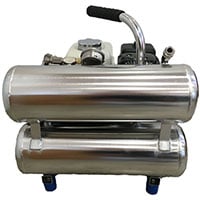
Static hookah air reserveThe air reserve tank (or 'receiver') operates as an air 'reservoir'. It provides a constant volume of air at all times. If you are diving under heavy exertion and demanding a greater amount of air, the large volume of air in the reserve tank will supply the reserve air required. If you were breathing directly from compressor itself, your rate of inhalation might actually surpass the air volume provided by the compressor, and you would not get a sufficient amount of air.
The reserve tank functions as a cooling and condensation vessel. Few divers realise it, but the air emerging from a hookah compressor is quite hot, and can actually reach temperatures as high as 190 degrees. As the air enters the reserve tank, it will expand and cool. This expansion process will also condense most of the water contained in the compressed air. Hookah compressors, because of their small size, do not have the capability to remove the moisture from the air and hence, they deliver air with an appreciable moisture content. The expansion process in the reserve tank allows the water to condense, ensuring that the diver breaths less moisture in the air.
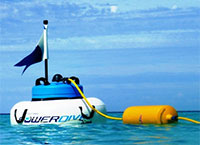
Floating hookah air reserveThe reserve tank also suppresses surges from the compressor or any temporary decrease in running speed. Often a compressor's engine will run uneven due to moisture in the petrol. The reserve tank can compensate for this by delivering an even flow of air.
Finally, the most important function of all. The reserve tank will contain enough pressurised air to give the diver a couple of minutes breathing time, should his compressor, or engine failure run out of fuel. (not that this is of much help if you're underwater and don't know, because there isn't anyone on the surface to signal you.) Equipment breakdown is not a pleasant thing to consider while working underwater, but is always a possibility. In the event of an engine failure without a reserve tank in the system, a diver could experience an immediate loss of air that could lead to desperation and panic. Any experienced diver will tell you, that panic is the leading cause of drowning incidents.
Hookah Breathing Air Hose
The hookah breathing air hose is attached to the air reserve tank. It's usually a bright yellow colour so that it's visible above and below the surface. Kink, collapse and abrasion-resistant, the air hose floats so that it doesn't entangle divers or underwater obstacles. As you might expect, one air hose supports one diver.
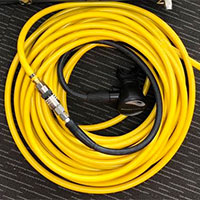
Hookah breathing air hoseHookah air hose is made of a special vinyl plastic construction, which is resistant to the effects of oil, gasoline and sunlight that exists in the environment. Conventional rubber scuba hose should never be used for hookah diving because it will gradually deteriorate and become toxic. Hookah hose commonly has an inside diameter of 8 mm or 10 mm. It is constructed of an inner liner of food-grade vinyl wrapped with a nylon webbing reinforcement and covered with a heavy-duty PVC abrasion resistant wall. Hookah hose is designed to prevent kinking and collapsing which could cause the flow of breathing air being shut off.
A quality surface supply diving systems hose will be coloured bright yellow for a high degree of visibility. It will also float, so that any excess hose not actually being used will float on the surface, completely away from the diver, reducing the possibility of entanglements on the bottom. For example, if you are diving in three metres of water but are using a 10-metre length of air hose, the excess seven metres will float on the surface, completely away from you. A quality hookah air will not impart any flavouring to the air and should meet AS2299 and AS1716 standards.
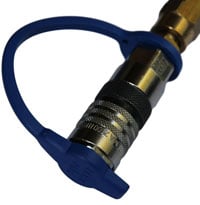
Hookah Unoflow couplingsWe recommend the use of high-quality, Australian made Barfell® Divers Air Breather Hookah hoses with an inside diameter of 8 mm for recreational diving and 10 mm for commercial diving. The Barfell hookah hoses meet Australian Standards AS2299 and AS/NZ1716.
We also recommend the use of commercial grade lockable Unoflow® quick couplings for safe hookah diving. We think the Unoflow product is superior to the equivalent TEMA product. The Unoflow quick connect is not compatible with the TEMA product.
Hose Configuration: A hookah breathing air hose is normally set up with a Male quick coupling at the compressor end, and a self-sealing Female quick coupling at the diver end. Thus when a hose is disconnected the female end self-seals and prevents air loss.
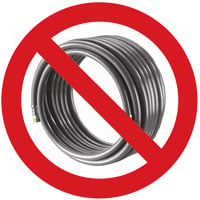
Bad workshop air hoseWarning: Using general-purpose air hoses (e.g. as used with workshop compressors and found at hardware stores) that are not certified for breathing air can potentially damage your lungs and is in breach of Workplace Health and Safety regulations. The lining inside many air hoses often deteriorates with age, oil and heat, potentially releasing toxic particles straight into the users breathing air supply. Incorrect hose connector fittings are also often easily damaged and accidentally disconnected, thereby cutting off the operators breathing air supply.
Don't risk your life by using inferior hookah hoses and couplings. We've seen candidates for the Darwin Awards use garden hoses and garden hose couplings in hookah systems!
Please see Hookah Hoses for the options we have available.
Hookah Regulator
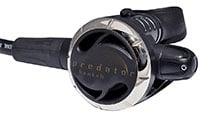
Hookah second stage regulatorThe hookah regulator is how the diver gets air. It fits in the diver's mouth and regulates the amount of air received when the diver inhales. A hookah regulator setup is entirely different from a scuba regulator. It consists of a 'second stage' only, which is fed directly from the output of the reserve tank via a hookah air hose. There are no tank valve and first stage regulator assemblies of the type that are used with scuba cylinders. You can't just plug your favourite scuba regulator into a hookah air line.
Hookah second stage regulators typically employ a 'tilt', or 'pin' valve, which delivers a full airflow to the diver at low-pressure. This type of regulator is specifically designed for use with low-pressure hookah compressors. Hookah second stage regulators, as are all modern regulators, are of the single hose, 'demand' type. A 'demand' regulator works on a relatively low volume of air since it only has to deliver air as the diver breathes, or 'demands' it.
Scuba second stage regulators can't be used for hookah applications without special modifications. A typical hookah compressor operates in a low-pressure range of 25 to 120 psi. That's not enough pressure to drive the spring-loaded downstream valve of a scuba second stage regulator which is typically driven by an air pressure ranging from 100 to 250 psi.
A diver who already owns a scuba second stage regulator, but who wishes to use it for hookah applications, must take the regulator to a competent dive shop and get the regulator converted over for low-pressure use. The conversion can be made by installing a set of low tension springs which will give maximum efficiency when operated at low hookah pressures. A dive shop will also have the necessary test equipment to make certain the adaptation has been effective.
Hookah Regulator Features
The better hookah regulators have several features for comfort and safety.
Venturi Switch: On better hookah regulators there is a venturi switch which has 'Pre-Dive' and 'Dive' positions. Because of the low pressures at which hookah regulators work, they are very sensitive to pressure. At the surface, where there is very little ambient pressure the regulator may have a tendency to free-flow. This isn't serious as you are not losing the limited amount of air from a scuba cylinder. If free flow occurs, simply put the venturi switch in the 'Pre-Dive' position. When ready to dive, move the venturi swith to the 'Dive' position.
Adjustment Knob: Better hookah regulators also have an adjustment knob. Under some conditions, such as very strenuous activity, if the breathing seems a bit laboured, you can reach up and open the knob by turning counter-clockwise to reduce the spring tension, making it easier to draw a breathe, but can increase the tendency to free flow. Turning the adjustment knob clockwise increases spring tension, making it a little harder to draw a breath, and reduces the tendency to free flow. You may want to try various settings of this knob during your first few dives to find the right position for you. The best practice is to set the regulator so that it breathes easily, just short of free flowing.
Reduce Jaw Fatigue
To reduce jaw fatigue and provide better whip hose routing, many hookah divers like to have a 360-degree omni-directional swivel adaptor, or a 20/70/110-degree swivel adaptor, at the second stage end of the whip hose. No matter how the diver's head is turned, the swivel will allow the hose to find the point of least resistance, thus eliminating jaw fatigue. This also allows improved whip hose routing by making it easier to have the hose go down the diver's chest and/or under the arm, eliminating hose push and giving you a more comfortable bite on your mouth piece. Your whip hose will lay closer to your body (under your arm) helping to eliminate tangles and improve streamlining.
 Sonar LP 360° Omni-Directional Swivel Adaptor for Regulator
Sonar LP 360° Omni-Directional Swivel Adaptor for Regulator
RRP: $64, Our Price: $61, You Save $3 (5%).
The Omni-swivel adaptor installs between the low pressure regulator whip hose and second stage regulator. The rotating 360° swivel action increases comfort and reduces jaw fatigue.
 Sonar LP 20/70/110-Degree Swivel Adaptor for Regulator
Sonar LP 20/70/110-Degree Swivel Adaptor for Regulator
RRP: $24, Our Price: $22, You Save $2 (8%).
Enables comfortable, streamlined underarm routing of the regulator whip hose. We prefer this 20/70/110-degree adaptor over a 90-degree adaptor because it angles the hose slightly away from the neck and face.
Hookah Regulator Safety Check Valve
For additional diver safety, the end of the hookah regulator hose should be connected to the outlet of a check valve. The check valve acts as a safety gate by shutting down the air system, allowing the air to travel in only in one direction. Should a burst or leak occur in the airline somewhere between the output of the compressor and the input of the check valve, it could prevent a vacuum occurring in the mouthpiece of the regulator or cause a diver to breathe in a large amount of water that could cause panic.
 AirDive One-Way Check Valve
AirDive One-Way Check Valve
Our Price: $70
The check valve is used on hookah diving systems for increased diver safety. This in-line, non-return check valve is used to ensure airflow is in one direction only.
You should never hookah dive without a check valve!
Retrieving Your Hookah Regulator
Should the regulator come out of your mouth while submerged, you should:
- Lean to your right side so the regulator whip hose hangs to that side
- Reach back with your right hand to where the regulator whip hose connects to the hookah harness to quickly find the regulator whip hose
- Run the regulator whip hose through your hand as you pull it in a sweeping motion toward your face
- You should end up with the regulator in your hand
- Use the purge button or forcefully exhale to clear the regulator after placing it back in your mouth
We recommend that you practice this manoeuvre near the surface until it can be done quickly and easily.
Please see Hookah Regulators for the options we have available.
Hookah Harness
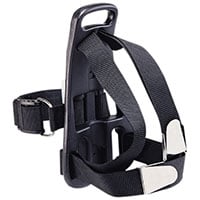
Hookah harnessThe hookah harness (or BCD) keeps the air hose from getting in the diver's way when working underwater. The diver's end of the hookah breathing air hose is securely attached to the harness or backplate which prevents any pulling motion from the regulator while working underwater. For example, if a diver were moving around underwater and inadvertently came to the end of the air hose, the harness would absorb the shock and the regulator and would not be jerked from the diver's mouth. Since the air hose terminates at the diver's back, it prevents potential entanglements around the diver's body.
The hookah harness typically has a backplate which is automatically positioned over the centre of the diver's back when the harness is worn. The backplate is often used to hold a bailout or emergency air source system.
Hookah harnesses are sometimes integrated with a weight belt, to counteract your body's natural buoyancy and make depth control easier. Some hookah divers prefer to use a BCD as well.
Please see Hookah Harnesses for the options we have available.
Hookah Emergency Air Systems
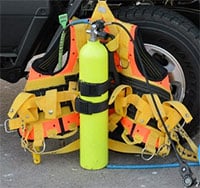
Commercial hookah harness with bailoutThe solution to preventing injury from a failed surface air supply while hookah diving is simple but it costs money — carry a bailout emergency air source and regulator. The money so spent on this life saver may well be your best investment ever!
We highly recommend a bailout cylinder setup, with a contents SPG gauge, should be used be used by each diver when hookah diving at depths greater than 6 metres (20 ft).
A suitable emergency air source converts a panic ascent into a leisurely trip to the surface. Compared to the overall cost of diving, boat and other equipment, the cost is relatively small.
Please ensure your accessory air source has a scuba cylinder of the appropriate size for the maximum depth you're diving to. You should plan to have enough air for around 15 minutes of breathing on the ascent with a decompression stop if necessary. Smaller all-in-one air regulators generally do not contain enough gas for a controlled ascent, although they are definitely far better than no spare air at all.
Decompression: No dive on Surface Supplied Breathing Apparatus (SSBA) should be carried out for a period of time that requires a decompression schedule unless each diver carries an independent reserve air supply to the amount required for the decompression plus at least 25% extra as a safety margin, and an oxygen delivery system is carried on the boat. You must be familiar with no-decompression limits, because given the long run time possible with most hookah diving systems, it is conceivable that, at certain depths, it may be possible to exceed the no decompression time limits for that depth. You must always stay within no decompression time limits for your maximum dive depth. Using a quality dive computer will help you with this.
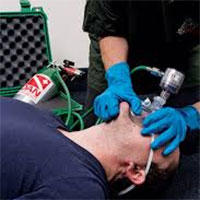
DAN emergency oxygen delivery systemOxygen: An appropriate oxygen delivery system should be carried on the boat for all hookah dives deeper than 15 metres (50 ft). The system should be capable of providing an inspired oxygen concentration of 100% to a patient who is either breathing spontaneously or requiring artificial ventilation. Sufficient oxygen should be provided to supply the delivery system, taking into account the location of the dive site and access to medical facilities.
Triple-Redundant Hookah Diving System
We recommend a triple-redundant air supply system should be used while doing advanced recreational and commercial hookah diving. The primary air supply is a low pressure (LP) hookah compressor. The secondary air supply is the bailout or emergency air system carried by the diver. Finally, in an emergency requiring additional time for diver extraction, there should be a tertiary air supply of a scuba cylinder suitably configured so that it can be used to provide air to the hookah diver(s). Some people keep this topside (e.g. on the boat) while others deploy it in the water for use at the safety stop (e.g. 5 metres).
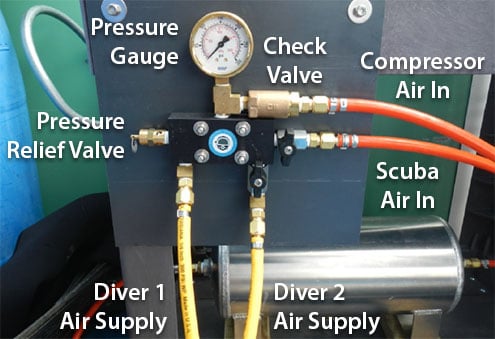
The distribution manifold configuration for a triple-redundant air supply system includes:
- Air supply in from compressor through a check-valve
- Scuba cylinder bailout supply in via a quarter turn isolation valve
- Outlets for two divers with diver-2 capable of being isolated for use in one diver mode
- An overpressure relief valve
- An operating (intermediate) pressure gauge. The gauge should normally read in the 100 to 140 psi range, however is frequently adjusted up to 150 psi for two diver use
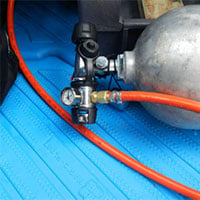
Scuba cylinder as a redundant air supplyThe scuba cylinder bailout air supply uses a first stage scuba regulator attached to the cylinder valve. It should have a SPG and its own pressure relief valve. The supply hose should be over-engineered to 2250 psi, however operates at only standard intermediate pressure. This is a fail-safe to ensure air supply to the diver(s) in an emergency. This cylinder should be 'on' during the dive, and isolated at the distribution manifold. Standard 'oxygen' brass fittings are used throughout the system. These are commonly used in commercial diving operations as they facilitate easy hose repair, and provide for readily available spares on-site.
Please see Hookah Emergency Air Systems for the options we have available.
Accessories, Hints and Precautions
Air Reserve Hose: One accessory hose item you will need on some hookah compressor setups is a short length of hose for routing the air output from the compressor to the input of the reserve tank. The type of hose that is needed depends upon the compressor you are using. Diaphragm models that operate in the 30 to 50 psi range use a simple hose connector that is made of hookah air hose. Larger high volume piston compressors that are capable of delivering pressure of 100 to 150 psi, require a connector made of special certified 'heat resistant steam' hose, due to the fact that these models discharge air at higher temperatures.
Stainless Steel or Brass: When setting up a hookah air system, you will frequently need an array of metal fittings. For use around water, you should use stainless steel or brass fittings only. This is especially important when diving in salt water. Fittings made of ferrous metal will rust or corrode when used in, or near a water environment.
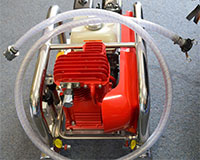
Hookah snorkelAir Inlet Snorkel: If your hookah compressor is powered by a petrol engine, make every effort to ensure that the engine exhaust (which contains deadly carbon monoxide gas), is always placed DOWNWIND from the compressor's air inlet. This will help prevent exhaust from being accidentally pulled into the compressor's air inlet. Always use a snorkel extension to elevate the intake of the air supply away from engine exhaust contaminates.
Air Inlet Hose: Always install a long extension on the air intake of your compressor to avoid the possibility of contamination of Carbon Monoxide Gas from the engine exhaust system. The air intake hose must be of sufficient internal diameter to prevent intake volumetric restrictions. The air intake of a compressor must tower over the engine exhaust at a sufficient height or distance to avoid intake of engine exhaust gas. If this gas is inhaled even in small quantities for short periods, it can cause severe headaches and possibly result in sickness. In larger quantities it can kill you, so please be careful!
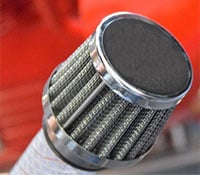
Hookah air inlet filterAir Inlet Filter: We highly recommend that all hookah systems be equipped with a filter on the air inlet. Air intake filters protect the compressor from any dust and dirt which it might suck in. Removal of particulate contamination is usually by a paper type dust filter.
Ventilation: Never use a gasoline powered compressor in confined areas, such as underneath piers, in close, narrow grottos, etc. This will prevent the exhaust gases from dissipating into the atmosphere safely. Also, never dive in an area where there is little ventilation or air movement. Take special precautions when diving in areas where the air is extremely still, as dead air spaces, or poor ventilation can cause exhaust gases to linger in the immediate area of the engine and compressor unit.
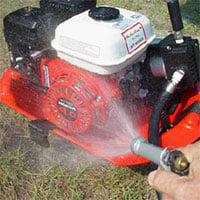
Hookah system cleaningCleaning: The key to long and productive life of your hookah diving system is in following a maintenance schedule. Yes, you will sometimes be tired and plan to clean up later, but invest the few minutes it will take to make sure that your hookah system is ready for the next adventure. If you are using hookah equipment around salt water, be sure to rinse off all your components with freshwater afterwards. This includes your regulator, diving mask, harness, metal fittings, and air hose (flush it out on the inside as well as outside). A salt water environment will quickly corrode aluminium parts such as: hookah compressors and petrol engines. It is advisable to keep all metal components freshly painted and cleaned to avoid excess corrosion.
Refuelling: If you are using a petrol powered compressor always shut of the engine before attempting to refuel. Do not attempt to refill the engine's petrol tank while the engine is still running, as this will increase the possibility of spilling petrol onto a hot engine, which could result in a potential fire or cause an explosion. A diver should always surface and shut off the engine prior to refueling and allow time for the engine to cool down. Always use a funnel for refilling the gas tank, or a special spill proof gas container to prevent spillage.
Hookah Equipment Care: Every hookah diver should understand the basic rudiments of engine and compressor maintenance, and should always keep his equipment in top condition. If you take proper care of your equipment, it will give you many years of trouble free service. Knowing how to work on your own equipment will also come in handy, should you experience any mechanical failure on a diving trip. It is a good idea to carry along some spare parts for your air compressor, and the necessary tools to make repairs. Log usage time and follow a maintenance plan.
UNDER NO CIRCUMSTANCES SHOULD YOU DIVE ALONE!
Always hookah dive with a buddy. Make sure that their equipment, as well as yours, is attached to the air system at all times. If you were to experience underwater problems, your diving buddy should be available to come to your immediate assistance.
Hookah System Servicing
It's extremely important that you properly maintain and service your hookah diving system. If you need an expert to help you with this, in Victoria we recommend:
Peter Cronin — Clean Air Servicing
Seaford VIC 3198
M: 0409 009 149
E: [email protected]Peter mostly services high pressure breathing air compressors as used by dive shops. However, he has been diving using low pressure hookah compressors for eons and is highly skilled in their service and repair.
Hookah Diving Hose Signals
These are the rope and diving hose signals used by the British Sub-Aqua Club. Most of them have the same meaning as the equivalent commercial or Royal Navy signal.
| Tender to Diver | Diver to Tender | |
|---|---|---|
| 1 pull | Are you all right? | I am all right. |
| 2 pulls | Stay put! | I am stationary! |
| 3 pulls | Go down! | I am going down! |
| 4 pulls | Come up at normal rate! | I am coming up! |
| 5 or more pulls | Emergency, come up to the surface! | Emergency, bring me to the surface! (No reply required) |
Effective hookah hose signals need a free down-line without much slack — before attempting a hose signal, the slack must be taken up, and the hose pulled firmly. Most signals are acknowledged by returning the same signal, which shows that it was received accurately. Persistent failure to acknowledge may indicate a serious problem and should be resolved as a matter of urgency. There are several systems in use, and it is necessary to have agreement between diver and tender before the dive.
Additional Hookah Diving Equipment You'll Need
- Dive Mask
- Fins
- Weight Belt and Diving Weights
- Wetsuit
- Dive Computer
- Dive Light for lighting up crevices in daytime, or for night dives
- Dive Knife
- Cray fishing? You'll need some specialty lobstering gear
Whether you're searching for sea life, watching for wrecks or photographing coral formations, hookah diving offers freedom and ease into the underwater world.
The Scuba Doctor has an excellent range of complete hookah diving systems, plus components and accessories for recreational and commercial hookah divers. See Hookah Diving.

